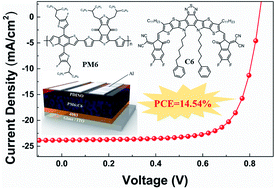Annealing-free efficient organic solar cells via an alkylbenzene side-chain strategy of small-molecule electron acceptors†
Abstract
Research on alkylbenzene side-chain engineering of acceptors, which can affect the crystallinity of molecules and packing orientations of blend films, has deeply promoted the development of organic solar cells (OSCs). In this contribution, we developed two novel small-molecule electron acceptors C4 and C6. They exhibit similar optical (an absorption edge reaching 900 nm) and electrochemical properties (narrow band gap, Eg ≈ 1.55 eV), but their photovoltaic properties are quite different. The power conversion efficiency (PCE) of C6-based OSCs is 14.54% (VOC = 0.84 V, JSC = 23.82 mA cm−2, and FF = 72.68%), which is much higher than that of the C4-based control device (7.28%). The difference of PCE is because C6 shows excellent compatibility with the polymer donor PM6. The subtle change of the alkylbenzene side chain is found to have a great impact on the blend film morphology. Compared to PM6:C4 blend films, PM6:C6 blend films exhibit a smaller π–π stacking d-spacing (3.61 Å) and larger coherence length (CCL = 17.7 Å), which is beneficial to promote charge transfer, further affecting the PCE of OSCs. Notably, devices based on PM6:C6 can achieve 14.54% efficiency, which is one of the best efficiencies of annealing-free OSCs (AF-OSCs). In reality, AF-OSCs relatively simplify the device manufacturing process compared to annealed cells, manifesting remarkable application potential in the future.



 Please wait while we load your content...
Please wait while we load your content...